
|
|
| . |
Comparing Different Move Times with
|
|||||||||||||||||||||||||||||||||||||||||||||||||||||||||||||||||||||||||||||||||||||||||||||||||||||||||||||||||||||
Total motion time = move time + settling time |
What is move time?
The time it takes to initially get to the target position (for the first time), not necessarily settled.
What is settling time?
The time between when the target position is reached for the first time and when it has settled on the target position (no ringing).
What is total motion time?
The total time that it takes from the moment the motion starts until a motion done event is received (move time + settling time).
In the examples below, we will demonstrate the following key points:
|
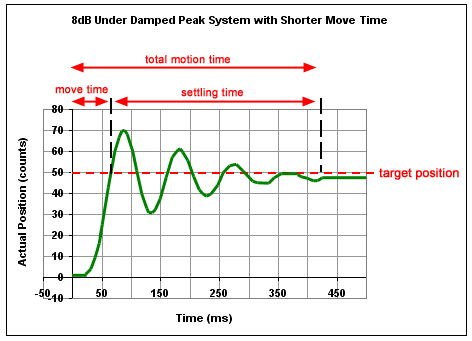
To help us better understand the topic of settling, we will use an analogy of a spring in a mechanical system. Let's say there is a spring hanging from the ceiling. If a weighted box is attached to the end of the spring forcing it to stretch, ![]() is the change in position from the spring's equilibrium state (no weight attached).
is the change in position from the spring's equilibrium state (no weight attached).
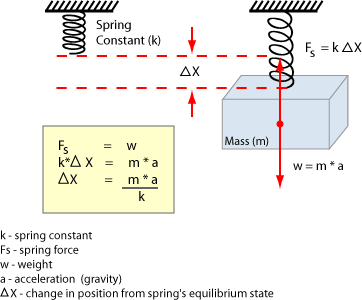
Bouncing Spring Analogy |
Sample System |
| Spring constant (k) | Kp - proportional gain |
| Change in position (X) | Position Error |
| Acceleration (a) | Acceleration (a) |
As the acceleration increases, position error increases (vice versa). Increasing Kp would decrease position error, but Kp can only be increased as long as the system is not overshooting or oscillating. When Kp is at its maximum, another way to reduce position error is to add the accleration feed forward term (Kaff) to the control loop.
The system that we will be testing consists of an XMP-SynqNet controller, an RMB-10V2 and a Trust Automation TA9000 test stand.
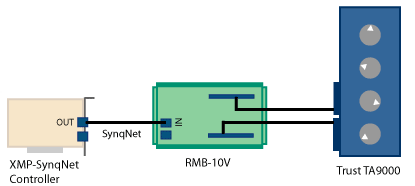
The examples below will demonstrate two main points:
|
Let's assume that we have already tuned the system and that there is an 8dB under damped peak at ~23 Hz. Therefore, we would expect the system to have an under damped motion profile at the ~23Hz frequency. To determine a rough estimate of when the target position will be reached for the first time, we will use the following calculation:
1/location of under damped peak = 1/23Hz = ~45ms
Therefore, we would expect it to reach the target position at ~45ms.
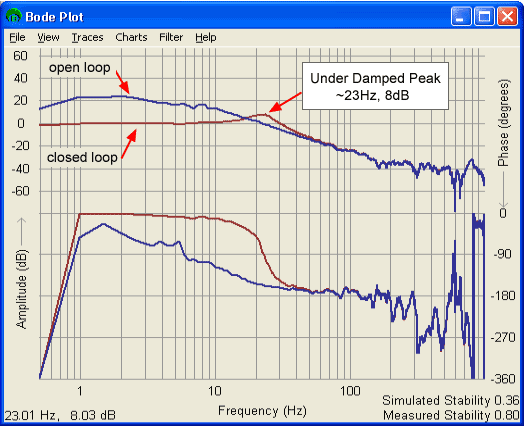 |
||
| Trust Automation TA9000 8dB Under Damped Peak System Kp = 408 Ki = 0 Kd = 1000 |
Red - Closed Loop Response Blue - Open Loop Response |
|
However, when we perform a motion profile on the actual system at the ~23Hz frequency, it reaches the target position at ~60ms, not at the expected ~45ms. See graph below.
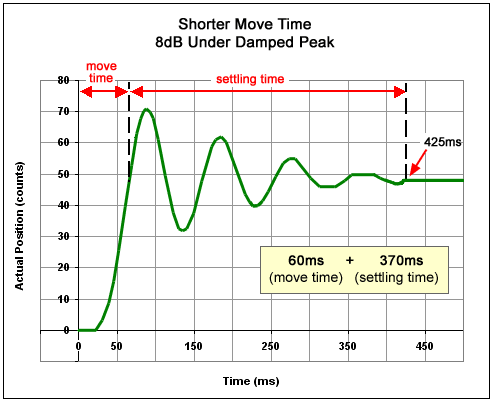 |
||
| Trust Automation TA9000 8dB Under Damped Peak System |
50 count move 1.25e+005 velocity, acceleration, deceleration |
|
Notice that the move (initially) reached the target position at 60ms and had 370ms of settling time. It finally settled at the target position at 425ms.
The ringing cycles indicate that the move is less stable. Ringing is caused by moves that are shorter than the closed loop bandwidth that do not have an acceleration feed forward term (Kaff).
Now let's see a how long it takes to reach the target position when a much longer move time is used. See graph below.
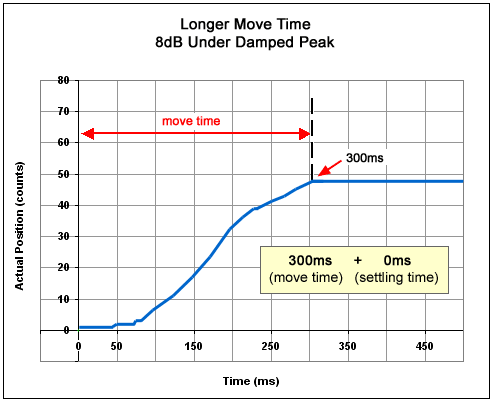 |
||
| Trust Automation TA9000 8dB Under Damped Peak System |
50 count move 7.8e+003 velocity, acceleration, deceleration |
|
Notice that there was 0ms of settling time and that it finally settled at the target position at 300ms.
In the profile above, the move time was increased 5x (60ms to 300ms). As a result, it was actually settled at the target position in less time than the profile with the shorter move time.
Settled at Target Position |
|
Move Type |
Time |
| Short Move Time | 425ms |
| Long Move Time | 300ms |
Therefore, it is important to note that if the main objective it to be settled at the target position as soon as possible, a longer move time might be the best choice. But, if the objective is to get to the target position as soon as possible (regardless of whether it's settled) then obviously using a shorter move time is the best choice.
In the next example, the system is tuned with a 4dB under dample peak at ~18Hz.
Therefore, we would expect the system to have an under damped motion profile at the ~18Hz frequency. To determine a rough estimate of when the target position will be reached for the first time, we will use the following calculation:
1/location of under damped peak = 1/18Hz = ~56ms
Therefore, we would expect it to reach the target position at ~56ms.
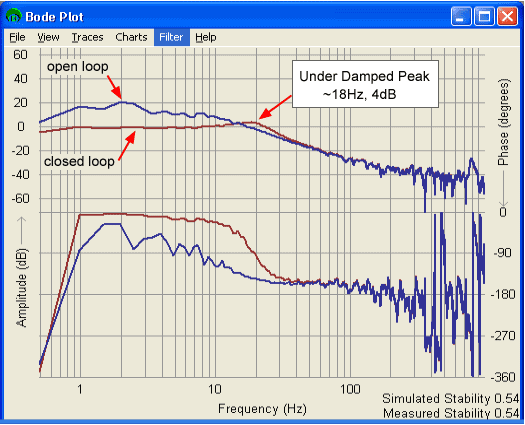 |
||
| Trust Automation TA9000 4dB Under Damped Peak System Kp = 245 Ki = 0 Kd = 1000 |
Red - Closed Loop Response Blue - Open Loop Response |
|
Let's see the move profile at ~18Hz.
Although the move reaches the target position after ~90ms, it takes another ~190ms to settle.
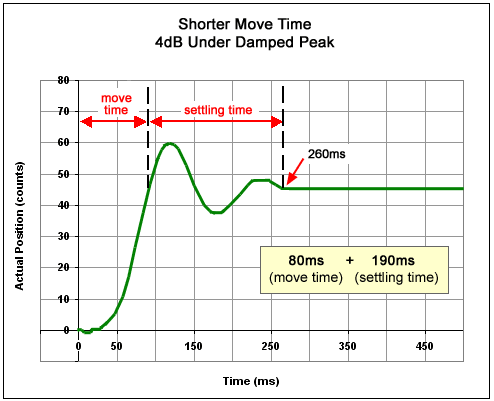 |
||
| Trust Automation TA9000 4dB Under Damped Peak System |
50 count move 8.9e+004 velocity, acceleration, deceleration |
|
Notice that the move reached the target position at 90ms and had 190ms of settling time. It finally settled at the target position at 260ms.
Now let's see a how long it takes to reach the target position when a much longer move time is used. See graph below.
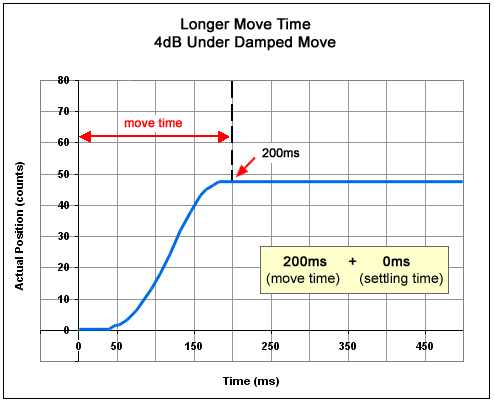 |
||
| Trust Automation TA9000 4dB Under Damped Peak System |
50 count move 1.5e+004 velocity, acceleration, deceleration |
|
Notice that there are 0ms of settling time and that it finally settles at the target position at 200ms.
In the profile above, the move time was increased 2.5x (80ms to 200ms). As a result, it was actually settled at the target position in less time than the profile with the shorter move time.
Settled at Target Position |
|
Move Type |
Time |
| Short Move Time | 260ms |
| Long Move Time | 200ms |
Once again, it is important to note that if the main objective it to be settled at the target position as soon as possible, a longer move time might be the best choice. But, if the objective is to get to the target position as soon as possible (regardless of whether it's settled) then obviously using a shorter move time is the best choice. Also notice that there is less ringing in the 4dB under damped peak system than the 8dB under damped peak system because, smaller under damped peaks will result in less ringing near or above the under damped peak frequency.
In the next example, the system is tuned with a 0dB under damped peak at ~20Hz.
Therefore, we would expect the system to have an under damped motion profile at the ~20Hz frequency. To determine a rough estimate of when the target position will be reached for the first time, we will use the following conversion:
1/location of under damped peak = 1/20Hz = ~50ms
Therefore, we would expect it to reach the target position at ~50ms.
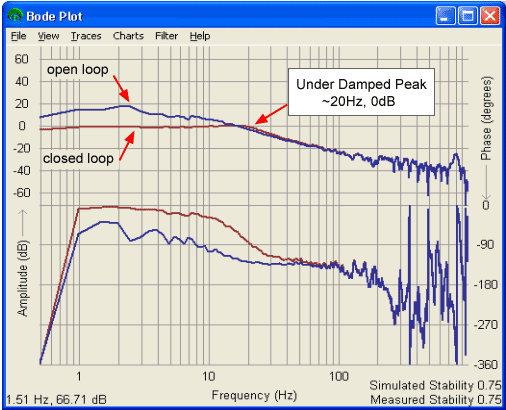 |
||
| Trust Automation TA9000 0dB Under Damped Peak System Kp = 200 Ki = 0 Kd = 2000 |
Red - Closed Loop Response Blue - Open Loop Response |
|
Let's see the move profile at ~50Hz.
Although the move reaches the target position after ~60ms, it takes another ~190ms to settle.
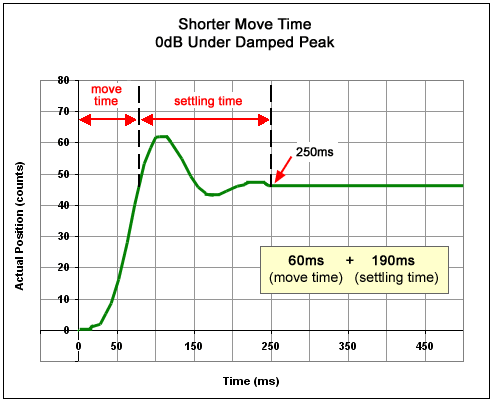 |
||
| Trust Automation TA9000 0dB Under Damped Peak System |
50 count move 8.9e+004 velocity, acceleration, deceleration |
|
Notice that the move reaches the target position at 60ms and has190ms of settling time. It finally settles at the target position at 250ms.
Now let's see a how long it takes to reach the target position when a much longer move time is used. See graph below.
 |
||
| Trust Automation TA9000 4dB Under Damped Peak System |
50 count move 1.5e+004 velocity, acceleration, deceleration |
|
Notice that there are 0ms of settling time and that it finally settles at the target position at 200ms.
In the profile above, the move time was increased from 60ms to 200ms. As a result, it was actually settled at the target position in less time than the profile with the shorter move time.
Settled at Target Position |
|
Move Type |
Time |
| Short Move Time | 250ms |
| Long Move Time | 200ms |
Once again, it is important to note that if the main objective it to be settled at the target position as soon as possible, a longer move time might be the best choice. But, if the objective is to get to the target position as soon as possible (regardless of whether it's settled) then obviously using a shorter move time is the best choice. Also notice that there is less ringing in the 0dB under damped peak system than the 4dB under damped peak system because, smaller under damped peaks will result in less ringing near or above the under damped peak frequency.
While most systems with resonance can still have ringing with longer move times, adding a Acceleration Feed Forward term (Kaff) to most systems should definitely reduce ringing. While servo gain values might cause instability, adding Kaff does not cause instability because it works outside of the control loop. Using Kaff can greatly improve the dynamics of a servo system.
Let’s look at another system with resonance and see what affect adding Kaff will have on the motion profile.
To emphasize the effect that an acceleration feedforward term has on reducing ringing cycles, we will use the same longer move profile as Example 1. An increased velocity (7.8e+003 velocity) will be used to make the ringing cycles more procounced.
The move profile yields a 16dB under damped peak at ~6Hz.
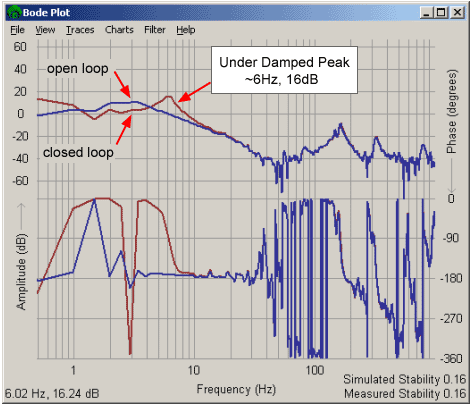 |
||
| Trust Automation TA9000 16dB Under Damped Peak System Kp = 408 Ki = 0 Kd = 1000 |
Red - Closed Loop Response Blue - Open Loop Response |
|
The move profile when no Kaff is used has many ringing cycles and a settling time of 1750ms.
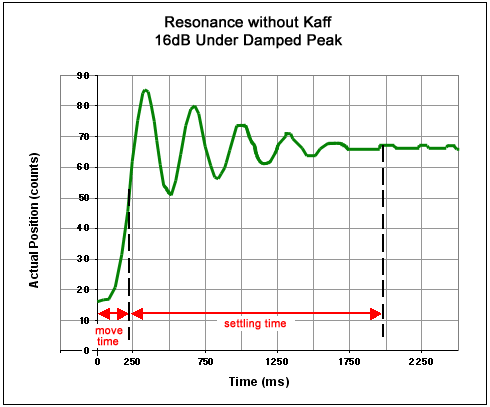 |
||
| Trust Automation TA9000 16dB Under Damped Peak System |
50 count move 7.8e+003 velocity, acceleration, deceleration |
|
However, when Kaff is used (see graph below), the ringing and settling time has been greatly reduced.
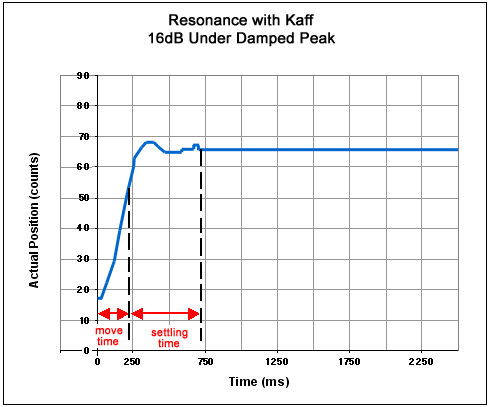 |
||
| Trust Automation TA9000 16dB Under Damped Peak System |
50 count move 7.8e+003 velocity, acceleration, deceleration |
|
As you can see, the addition of an acceleration feedforward term (Kaff) can result in a more stable system with reduced ringing cycles and settling time.
|
| | | Copyright © 2001-2021 Motion Engineering |